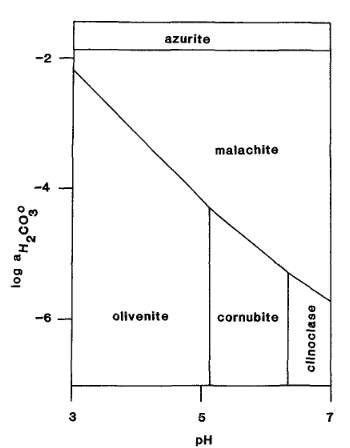Associated minerals include clinoclase, conichalcite, tyrolite, cornetite, cornwallite, metazeunerite, scorodite, pharmacosiderite, spangolite, chalcophyllite, brochantite, malachite, azurite and chrysocolla (HOM).
Localities
At the Block 14 open cut, Broken Hill, New South Wales, Australia, olivenite occurs with beudantite-segnitite, bayldonite, mawbyite and mimetite. Later sulphate minerals such as brochantite and linarite also occur on some specimens (AJM 3.1.54).
Olivenite from Broken Hill - Image
At the New Cobar deposit, New South Wales, Australia, olivenite occurs in vugs in quartz, associated with chenevixite and agardite, and almost always associated with partially oxidised arsenopyrite (AJM 11.2.80).
Olivenite from the New Cobar Deposit - Image
At the Desolation prospect, Mount Isa Block, Queensland, Australia, olivenite is found on chrysocolla, associated with clinoclase. Olivenite and libethenite also occur on earlier chrysocolla and As-rich pseudomalachite crusts (AJM 17.2.86).
At the Bali Lo prospect, Ashburton Downs, Western Australia, olivenite occurs intergrown with chenevixite (AJM 13.1.34-35).
Olivenite from the Bali Lo Prospect - Image
At the Telfer gold mine, Western Australia, olivenite has been found radiating from cavity surfaces in quartz veins overgrown by chrysocolla (AJM 12.1.39).
At the Clara mine, Near Wolfach in the Black Forest, Germany, olivenite and its associated minerals agardite-(Ce), cornwallite and clinoclase, are perched on a fluorite and/or baryte matrix with disseminated tetrahedrite-tennantite. Also an olivenite-adamite solid solution is found associated with philipsburgite (R&M 90.1.45).
Olivenite from the Clara Mine - Image
At Ightem, Bou Azzer, Morocco, zinc-rich olivenite occurs associated with powellite (MinRec 38.5.385).
Olivenite from Ightem - Image
At Tamdrost-West, Bou Azzer, Morocco, cobalt and nickel-rich olivenite has been found in cavities in quartz associated with pharmacosiderite (MinRec 38.5.385).
At Tsumeb, Namibia, olivenite occurs with azurite and malachite (R&M 93.6.546), and also with adamite, zincolivenite, duftite/conichalcite and arsentsumebite, often on quartz (R&M 95.3.210-232).
Olivenite is relatively common in the first and second oxidation zones. The olive-green to greenish brown crystals to 2.5 cm are considered the finest known examples of the species. Typical habits are radially structured masses and botryoidal mounds, prismatic crystals and tabular crystals. The colour dependeds on the zinc content, with the paler green, better-developed crystals being higher in zinc content, and the darker green crystals in prismatic sprays being higher in iron. Olivenite from the first oxidation zone occurs in tight clusters up to 5 cm wide; these are the finest known examples of the species. Associations can include segnitite, rosasite, gartrellite, wulfenite, lukrahnite, plancheite, germanite, bayldonite, ferrilotharmeyerite, dundasite, arsentsumebite, metazeunerite, beudantite, mimetite and native silver, as well as the minerals listed above (Minrec 55.6.135).
Olivenite from Tsumeb - Image
At the Chinkuashih mine, Ruifang District, New Taipei City, Taiwan, olivenite has been found with pharmacosiderite and quartz (Mindat photo).
Olivenite from the Chinkuashih Mine - Image
The type locality is the Carharrack Mine, Gwennap, Cornwall, England, UK.
Olivenite from the Carharrack Mine - Image
At Caldbeck Fells, Cumbria, England, UK, olivenite is rare. At Carrock mine and at Ingray Gill it occurs in cavities in quartz. At Dry Gill mine it has been found with beudantite, and at Old Potts mine it has been found with cornwallite and conichalcite (C&S).
At the San Rafael mine, Nye county, Nevada, USA, olivenite occurs within zones containing mixite and conichalcite in the rosasite stope. Olivenite has also been documented here in association with cornubite and cornwallite (R&M 85.6.520).
Olivenite from the San Rafael Mine - Image
At the Majuba mine, Pershing county, Nevada, USA, olivenite is associated with cornetite (Dana).
Olivenite from Majuba Hill - Image
At the Tintic district, Utah, USA, olivenite is usually the first oxysalt to form during the oxidation of enargite. It is probably the most common of the arsenates. Enargite traversed by a network of olivenite veins is often seen. In colour, olivenite is olive-brown, olive-green, yellowish green, pure brown or rarely reddish brown. It occurs in every one of the copper mines at Tintic. At the Centennial Eureka mine, vugs completely lined with crystals of olivenite, up to 2 cm or more, are not uncommon (MinRec 55.2.215-216).
At the Mammoth mines, olivenite is associated with clinoclase, tyrolite and conichalcite (Dana).
Olivenite from Tintic - Image
Alteration
euchroite (s) to olivenite (s) and H2O (l)
Cu2AsO4(OH). 3H2O ⇌ Cu2AsO4(OH) + 3H2O
(MM 52.684)
The Activity-pH diagram below was calculated at 298.2 K for the main Cu2+ and Pb2+ arsenate minerals. Boundaries are calculated for constant activities (roughly equivalent to concentrations) of Pb2+ and Cl- ions in solution, over a range of values of pH and of Cu2+ activity. Higher chloride activites make the stability fields of bayldonite and duftite vanish, with respect to the encroachment of that of mimetite (LMW p269).

The arsenate mineral formulae are:
philipsbornite PbAl3(AsO4)(AsO3OH)(OH)6
mimetite Pb5(AsO4)3Cl
duftite PbCu(AsO4)(OH)
bayldonite Cu3PbO(AsO3OH)2(OH)2
olivenite Cu2(AsO4)(OH)
cornwallite Cu5(AsO4)2(OH)4
clinoclase Cu3(AsO4)(OH)3
The Activity-pH diagram below was calculated at 298.2 K for some carbonates and copper arsenates for constant activity (roughly equivalent to concentration) of H2AsO4- in solution, over a range of values of pH and of H2CO3 activity (MM 52.687).

The mineral formulae are:
azurite: Cu3(CO3)2(OH)2
malachite: Cu2(CO3)(OH)2
olivenite: Cu2(AsO4)(OH)
cornubite: Cu5(AsO4)2(OH)4
clinoclase: Cu3(AsO4)(OH)3
The Activity-pH diagram below was calculated at 298.2 K for some arsenates and sulphates for constant activity (roughly equivalent to concentration) of H2AsO4- in solution, over a range of values of pH and of SO42- activity (MM 52.689).

The mineral formulae are:
chalcanthite: Cu(SO4).5H2O
antlerite: Cu2+3(SO4)(OH)4
brochantite: Cu4(SO4)(OH)6
olivenite: Cu2(AsO4)(OH)
cornubite: Cu5(AsO4)2(OH)4
clinoclase: Cu3(AsO4)(OH)3
Back to Minerals